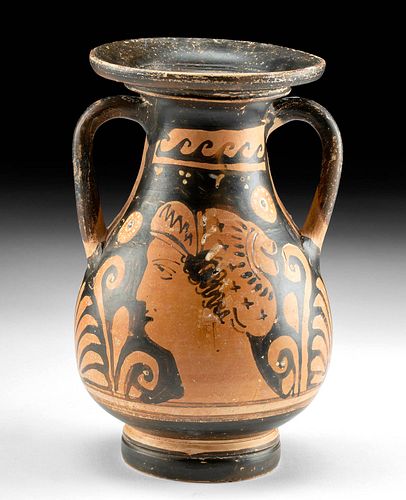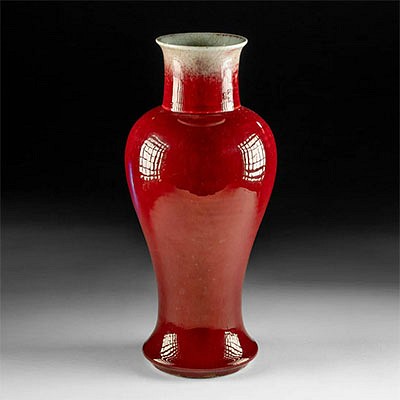Apulian Red-Figure Pelike, Group of Zurich 2661
Lot 27
About Seller
Artemis Fine Arts
686 S Taylor Ave, Ste 106
Louisville, CO 80027
United States
Selling antiquities, ancient and ethnographic art online since 1993, Artemis Gallery specializes in Classical Antiquities (Egyptian, Greek, Roman, Near Eastern), Asian, Pre-Columbian, African / Tribal / Oceanographic art. Our extensive inventory includes pottery, stone, metal, wood, glass and textil...Read more
Categories
Estimate:
$4,000 - $6,000
Absentee vs Live bid
Two ways to bid:
- Leave a max absentee bid and the platform will bid on your behalf up to your maximum bid during the live auction.
- Bid live during the auction and your bids will be submitted real-time to the auctioneer.
Bid Increments
| Price | Bid Increment |
|---|---|
| $0 | $25 |
| $300 | $50 |
| $1,000 | $100 |
| $2,000 | $250 |
| $5,000 | $500 |
| $10,000 | $1,000 |
| $20,000 | $2,500 |
| $50,000 | $5,000 |
| $100,000 | $10,000 |
| $200,000 | $20,000 |
About Auction
By Artemis Fine Arts
May 11, 2023
Set Reminder
2023-05-11 10:00:00
2023-05-11 10:00:00
America/New_York
Bidsquare
Bidsquare : Fine Antiquities, Asian, Pre-Columbian, Ethnographic Art
https://www.bidsquare.com/auctions/artemis-gallery/fine-antiquities-asian-pre-columbian-ethnographic-art-12771
Classical antiquities, ancient and ethnographic art from cultures encompassing the globe. Artemis Fine Arts info@artemisgallery.com
Classical antiquities, ancient and ethnographic art from cultures encompassing the globe. Artemis Fine Arts info@artemisgallery.com
- Lot Description
**Originally Listed At $2250**
Magna Graecia, South Italy, Apulian, attributed to the Group of Zurich 2661, ca. 350 to 325 BCE. A gorgeous Apulian olpe of an attractive form comprised of an ample piriform body rising to a cylindrical neck that flares at the rim, and twin strap handles joining neck to shoulder. The body is finely painted via the red-figure technique with two Lady of Fashion heads (one on each side) depicted in profile and bedecked with jewelry and a saccos with radiate stephane, all delineated via the red figure technique with jewelry and hair ornaments highlighed in white fugitive pigment. Adding to the decorative program are stylized palmettes beneath the handles, and registers of cresting wave motifs along the neck with bunches of grapes with leaves hanging below. Cruciform and dotted disc designs additionally adorn the field. A fabulous example, replete with impressive artistry and technique. Size: 4.3" Diameter x 7" H (10.9 cm x 17.8 cm)
Perhaps the most exciting innovation in Greek vase painting was the red-figure technique, invented in Athens around 525 BCE and beloved by other artists of Magna Graecia. The red-figure technique allowed for much greater flexibility as opposed to the black-figure technique, for now the artist could use a soft, pliable brush rather than a rigid metal graver to delineate interior details, play with the thickness of the lines, as well as build up or dilute glazes to create chromatic effects. The painter would create figures by outlining them in the natural red of the vase, and then enrich these figural forms with black lines to suggest volume, at times perspectival depth, and movement, bringing those silhouettes and their environs to life. Beyond this, fugitive pigments made it possible for the artist to create additional layers of interest and detail as we see in this example.
Another pelike by the Group of Zurich 2661 can be found at the Metropolitan Museum of Art under accession number 76.12.11. A similar pelike that has not been attributed is also found at Colorado University Art Museum under accession number 2006.15.T.
Provenance: private New York, New York, USA collection; ex-Schuler Auktionen, Zurich, Switzerland, December 13, 2021, lot 6311; ex-private Swiss collection, since the 1960s
All items legal to buy/sell under U.S. Statute covering cultural patrimony Code 2600, CHAPTER 14, and are guaranteed to be as described or your money back.
A Certificate of Authenticity will accompany all winning bids.
We ship worldwide and handle all shipping in-house for your convenience.
#177277Minor chipping to peripheries of rim and base, as well as expected nicks and abrasions throughout, all commensurate with age. Otherwise, intact and excellent with nice remaining detail and liberal remains of fugitive pigments.Condition
- Shipping Info
-
All shipping is handled in-house for your convenience. Your invoice from Artemis Gallery will include shipping calculation instructions. If in doubt, please inquire BEFORE bidding for estimated shipping costs for individual items. In most cases Artemis Gallery cannot ship to Australia and Germany, please inquire before bidding.
-
- Buyer's Premium



 EUR
EUR CAD
CAD AUD
AUD GBP
GBP MXN
MXN HKD
HKD CNY
CNY MYR
MYR SEK
SEK SGD
SGD CHF
CHF THB
THB














